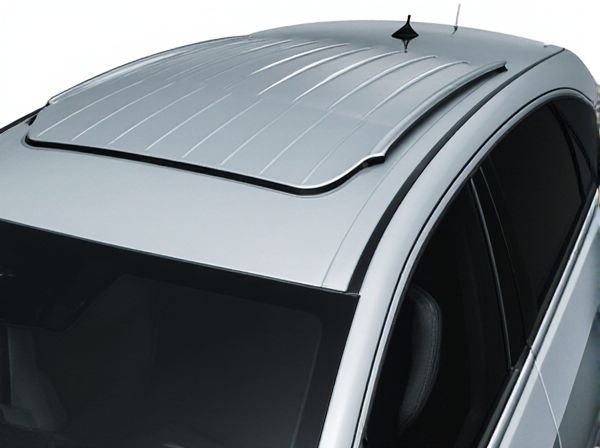
Photo illustration: Louvered Roof vs Non-louvered Roof
A louvered roof offers adjustable slats that allow you to control sunlight and ventilation, making outdoor spaces more versatile and comfortable. Non-louvered roofs provide a fixed, solid cover that offers consistent protection from rain and sun but lack customization options for airflow and light. Choosing between the two depends on whether you prioritize flexibility in climate control or a permanent shelter solution.
Table of Comparison
| Feature | Louvered Roof | Non-louvered Roof |
|---|---|---|
| Ventilation | Adjustable slats allow customizable airflow and light | Fixed roof restricts airflow, no adjustable ventilation |
| Weather Protection | Water-resistant when closed; can open partially for rain | Solid, provides full protection against rain and sun |
| Light Control | Slats control light intensity and direction | No light adjustment; fixed solid surface |
| Design & Style | Modern, sporty look with functional appeal | Traditional, simple design with solid appearance |
| Maintenance | Requires periodic cleaning of slats and mechanism | Lower maintenance with fewer moving parts |
| Durability | Durable but mechanical parts may wear over time | Highly durable due to solid construction |
| Cost | Generally higher due to mechanical complexity | Lower initial cost and repair expenses |
Introduction to Louvered and Non-louvered Roofs
Louvered roofs feature adjustable slats that allow precise control over sunlight, ventilation, and weather protection, enhancing outdoor living spaces with versatility and comfort. Non-louvered roofs, typically solid and fixed, provide consistent shelter and shade but lack the dynamic functionality of louvered systems, making them ideal for permanent coverage. Choosing between louvered and non-louvered roofs depends on the desired balance between flexibility, natural light management, and structural permanence.
Key Features of Louvered Roofs
Louvered roofs feature adjustable slats made from materials such as aluminum or wood, allowing customizable control over sunlight, ventilation, and rain protection. These roofs enhance outdoor living spaces with their ability to tilt open for airflow and close for shelter, providing year-round usability. The integration of motorized systems and weather sensors adds convenience and energy efficiency, distinguishing louvered roofs from their fixed, non-louvered counterparts.
Key Features of Non-louvered Roofs
Non-louvered roofs offer a solid, fixed structure that provides complete protection from rain, snow, and sunlight, unlike louvered roofs which allow adjustable light and ventilation. Key features of non-louvered roofs include high durability, minimal maintenance, and excellent insulation properties, making them ideal for year-round shelter. Their fixed panels ensure consistent coverage, enhancing energy efficiency by reducing heat loss or gain.
Aesthetic Appeal: Comparing Visual Design
Louvered roofs offer a modern, sleek aesthetic with adjustable slats that create dynamic visual interest and enhance architectural design. Non-louvered roofs typically provide a more traditional, solid surface look with a consistent appearance, often matching classic home or building styles. The choice between louvered and non-louvered roofs significantly impacts the overall external appeal, influencing light play, shadow patterns, and contemporary versus conventional design preferences.
Functionality and Flexibility
Louvered roofs offer enhanced functionality by allowing adjustable slats to control sunlight, ventilation, and rain protection, providing customizable outdoor comfort. Non-louvered roofs, typically fixed panels, deliver consistent shelter but lack the ability to regulate airflow or light, limiting flexibility. The adaptability of louvered roofs makes them ideal for variable weather conditions, whereas non-louvered roofs are better suited for permanent, unchanging coverage.
Weather Protection and Durability
Louvered roofs offer superior weather protection by allowing adjustable slats that control sunlight, rain, and airflow, making them ideal for varying weather conditions. Non-louvered roofs, typically solid structures, provide constant protection against rain and wind but lack ventilation options, which may lead to heat buildup. Durability varies with materials; aluminum louvered roofs resist corrosion and withstand harsh weather, while traditional non-louvered roofs depend on quality roofing materials like metal or reinforced polycarbonate for long-term resilience.
Energy Efficiency and Ventilation
Louvered roofs enhance energy efficiency by allowing adjustable airflow and natural ventilation, reducing reliance on air conditioning and promoting passive cooling. Non-louvered roofs lack this flexibility, often trapping heat and increasing indoor temperatures, which leads to higher energy consumption. Optimizing ventilation with louvered designs improves airflow management and lowers cooling costs in various climates.
Installation Process and Maintenance
Installing a louvered roof involves mounting adjustable slats that require precise alignment and mechanical or motorized components, making the process more complex and time-consuming compared to non-louvered roofs, which consist of fixed panels or sheets with simpler attachment methods. Maintenance for louvered roofs demands regular cleaning of slats and lubrication of moving parts to ensure smooth operation, whereas non-louvered roofs require less frequent upkeep focused mainly on debris removal and roof surface inspections. Choosing between the two depends on balancing the benefits of adjustable shading and ventilation against the ease of installation and lower maintenance needs.
Cost Comparison: Louvered vs Non-louvered Roofs
Louvered roofs typically have higher initial costs compared to non-louvered roofs due to their complex mechanism and use of durable materials like aluminum. Non-louvered roofs, often made from simpler materials such as polycarbonate or fixed metal panels, offer a more budget-friendly option with lower installation expenses. Maintenance costs for louvered roofs can also be higher, reflecting the need for regular upkeep of moving parts, whereas non-louvered roofs generally incur less maintenance spending.
Choosing the Right Roof for Your Space
Louvered roofs offer adjustable slats that provide versatile control over sunlight and ventilation, making them ideal for outdoor spaces requiring customizable shade and airflow. Non-louvered roofs deliver a fixed, solid cover that ensures constant protection from rain and harsh weather, suitable for areas needing consistent shelter. Selecting the right roof depends on your specific needs for light control, weather protection, and aesthetic preferences in your space.
 caratoz.com
caratoz.com